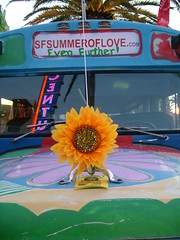 |
| Summer of Love (Photo credit: teamstickergiant) |
By the time the fabled Summer of Love hit San Francisco 40 years ago, the party was already over in the Haight-Ashbury.
Yet the mythology of that summer in 1967 has never disappeared.
The San Francisco hippie, dancing in Golden Gate Park with long hair flowing, has become as much of an enduring American archetype as the gunfighters and cowboys who roamed the Wild West.
More importantly, the rise of '60s counterculture has had a significant impact on our culture today. The Summer of Love resonates in strip mall yoga classes, pop music, visual art, fashion, attitudes toward drugs, the personal computer revolution, and the current mad dash toward the greening of America.
While some of the counterculture's dreams came true, others, particularly the movement's idealistic politics, evaporated like the sweet-smelling pot smoke that saturated the air that summer.
 |
| Hippie Bus from the Summer of Love (Photo credit: Jill Clardy) |
"It was sex, drugs and rock 'n' roll, and those were all fun," says social satirist Paul Krassner. "But at the core of the counterculture was a spiritual revolution."
In the weeks leading up to the end of the 1967 school year, while many of the more forward-thinking of the Haight community left town to continue their social experiments elsewhere, San Francisco braced for an anticipated onslaught of more than 100,000 young transients for a psychedelic circus in Haight-Ashbury.
"The Invasion of the Flower Children" announced one Chronicle headline. The phrase itself, Summer of Love, echoed for months in advance throughout the national media, which took great delight in cluck-clucking over those kooky kids out in San Francisco, the ones on space-age drugs who called themselves hippies.
There couldn't have been better advertising. College students read about the Human Be-In in Golden Gate Park in January 1967. Some of them came to check things out during spring break. The rest couldn't wait for the school year to be over.
That summer was ripe for change. It was only two years after the Watts riots in Los Angeles, 3 1/2 years after the Kennedy assassination, and more and more American troops were being sent to fight in the Vietnam War.
Against the backdrop of an ever-widening chasm between the nation's youth and their parents that would eventually be dubbed "the generation gap," young people all over the country headed toward San Francisco.
"It was sort of like a farmer unloading a truckload of onions - once the onions start to move, there's no stopping them," says Carolyn Garcia by telephone from her home in Oregon. At the time, she was known as Mountain Girl and lived at 710 Ashbury St. with her boyfriend (and eventual husband), guitarist Jerry Garcia and the rest of his band, the Grateful Dead.
"That's kind of how it felt, that the streets were just filling up with people, vegetables yearning to be free," she says with a laugh. Ground zero for the Summer of Love was an old San Francisco neighborhood filled with large Victorian rooming houses built for Irish workers, where a student could get a room for as little as $25 a month.
San Francisco State was a bus ride away and, in those early, innocent days, just after the Beatles came to America, the beatnik underground had begun to drift away from the coffeehouses and jazz clubs of North Beach into the Haight.
Read more: http://www.sfgate.com/news/article/Summer-of-Love-40-Years-Later-1967-The-stuff-2593252.php#ixzz23U0vzb38

No comments:
Post a Comment